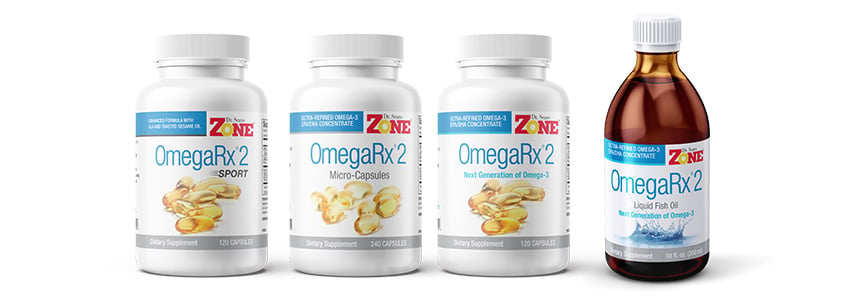Both the medical profession and the general public are becoming more aware that omega-3 fatty acids are critical to human health without knowing why. What most medical professionals don’t understand is that omega-3 fatty acids are relatively weak anti-inflammatory compounds. Yet they are also the building blocks for potent pro-resolution hormones known as resolvins. Inflammation and resolution are very different concepts. Anti-inflammatory means reducing the intensity of inflammation, whereas pro-resolution means the actual turning off of inflammation. Increasing resolution is an entirely different pathway than merely reducing the intensity of inflammation (anti-inflammation), as I explain in my newest book, The Resolution Zone.
Furthermore, the importance of dosage when discussing the role of omega-3 fatty acids is often misunderstood. Taking a placebo dose of omega-3 fatty acids will give you placebo levels of resolvins. You can’t heal from any type of injury unless you completely resolve inflammation by making adequate levels of resolvins. What’s an appropriate level? Based on recent studies, it appears to be at least three grams of EPA and DHA per day. Finally, there is a big difference in the potency, purity, and price of omega-3 fatty acids depending on whether you plan to consume fish as your source or purchase fish oil supplements.
ConsumerLab.com recently published a compilation of the commonly consumed fish that are rich in omega-3 fatty acids. The primary sources of fish rich in omega-3 fatty acids are salmon, sardines, and tuna. Using a serving size of about 2 ounces the calculated cost of raw fish from various market sources required to obtain 1 gram of EPA and DHA are the following.

Therefore to consume three grams of EPA and DHA per day from these commonly used sources of fish, you are looking to spend between $4.50 and $33 per day. Yikes!
Price is not the only issue as you have to contend with the contaminant issue in fish. Sardines are the least expensive choice for omega-3 fatty acids, but crude sardine oil is relatively rich in toxins such as polychlorinated biphenyls or PCBs. Sardines are the primary source of raw material to make fish oil supplements. Crude sardine oil is relatively rich in PCBs, which have well known toxic effects to your cardiovascular, neurological, and immunological systems. The State of California has issued safety alerts not to consume more than 90 nanograms (0.00000090 grams) of PCBs per day. Salmon (at least wild salmon) are much lower in PCBs than are sardines. Thus they would be a safer alternative for EPA and DHA as well as a better-tasting choice than sardines. Unfortunately, most salmon comes from farmed raised salmon. To effectively grow farm-raised salmon requires the use of crude sardine oil to promote their growth so they will contain more PCBs than wild salmon. Tuna, which is far more expensive per gram of EPA and DHA than salmon, has additional problems in that it is relatively rich in mercury (especially albacore tuna). These mercury levels limit its consumption to once or twice a week, making it virtually impossible to obtain three grams of EPA and DHA per day by eating tuna.
So, maybe fish oil supplements can be a more cost-effective source of omega-3 fatty acids, assuming you can solve the PCB and mercury contaminant problems in fish. First, fish oil is not the same as omega-3 fatty acids. It is only the omega-3s EPA and DHA that have health benefits. The other fatty acids in fish oil are simply along for the ride. So, the potency becomes a significant concern to get to the goal of three grams of EPA and DHA per day. It is pretty easy to remove mercury from crude fish oil. However, that is not the case for PCBs. Remember that most fish oil supplements come from crude sardines (or anchovies) whose crude fish oil is relatively rich in PCBs, as I mentioned above. The standard upper limit used in the supplement market for a “safe” fish oil product is 90 nanograms of PCBs per gram of fish oil. Using the usual standard for PCBs means the maximum intake of a typical fish oil supplement you could safely consume per day is about 1 gram. One gram of a regular fish oil supplement might contain between 30 and 60 percent EPA and DHA. Thus, consuming one gram of fish oil would contain between 0.3 to 0.6 grams of EPA and DHA per day before you would exceed the maximum daily intake of 90 nanograms of PCBs per day. Unfortunately, this is 5 to 10 times less EPA and DHA than you need to make the necessary levels of resolvins that turn off inflammation.
At this point, you might think its impossible to consume enough EPA and DHA daily. There is a way out; the use of more purified fish oil supplements much lower in PCBs as well as more potent in EPA and DHA. That is the perfect description of OmegaRx 2. By using new manufacturing techniques, it is possible to reduce the stated upper limits of PCBs in OmegaRx 2 to be less than 2 ppb, which is 45 times lower than what you find in a health food store or a supermarket. (Actually, most of our lots of OmegaRx 2 are 20 times lower than our stated upper limits of 2 parts per billion of PCBs. That’s why we post the levels of every lot of OmegaRx 2 we sell on our website).
Furthermore, more than 75 percent of the fatty acids in OmegaRx 2 are composed of EPA and DHA. So, to get 3 grams of EPA and DHA per day, you only need to consume 4 grams (or four capsules) of OmegaRx 2. And the upper levels of PCBs in that 4 grams would be less than eight nanograms, which is more than ten times lower than the upper limits set by every health agency in the world.
In conclusion, you need adequate amounts of EPA and DHA for optimal health. Three grams per day would be an excellent daily target dose. What you want to look for is purity, potency, and price. No fish oil product has as rigid a purity standard as OmegaRx 2, and virtually none is equally potent. Furthermore, the cost of 3 grams of EPA and DHA in OmegaRx 2 is about $1.80 per day or about four dollars per day less expensive than salmon to get the same amount of omega-3 fatty acids with much higher purity. Once you factor in purity, potency, and price, OmegaRx 2 is not only the most potent and pure choice for getting the adequate levels of EPA and DHA you need daily to resolve diet-induced inflammation but also is the least expensive choice.








Let Us Know What You Thought about this Post.
Put your Comment Below.